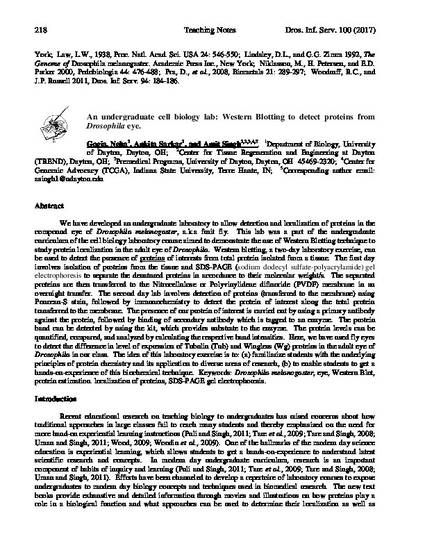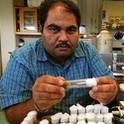
We have developed an undergraduate laboratory to allow detection and localization of proteins in the compound eye of Drosophila melanogaster, a.k.a fruit fly. This lab was a part of the undergraduate curriculum of the cell biology laboratory course aimed to demonstrate the use of Western Blotting technique to study protein localization in the adult eye of Drosophila. Western blotting, a two-day laboratory exercise, can be used to detect the presence of proteins of interests from total protein isolated from a tissue. The first day involves isolation of proteins from the tissue and SDS-PAGE (sodium dodecyl sulfate-polyacrylamide) gel electrophoresis to separate the denatured proteins in accordance to their molecular weight/s. The separated proteins are then transferred to the Nitrocellulose or Polyvinylidene difluoride (PVDF) membrane in an overnight transfer. The second day lab involves detection of proteins (transferred to the membrane) using Ponceau-S stain, followed by immunochemistry to detect the protein of interest along the total protein transferred to the membrane. The presence of our protein of interest is carried out by using a primary antibody against the protein, followed by binding of secondary antibody which is tagged to an enzyme. The protein band can be detected by using the kit, which provides substrate to the enzyme. The protein levels can be quantified, compared, and analyzed by calculating the respective band intensities. Here, we have used fly eyes to detect the difference in level of expression of Tubulin (Tub) and Wingless (Wg) proteins in the adult eye of Drosophila in our class. The idea of this laboratory exercise is to: (a) familiarize students with the underlying principles of protein chemistry and its application to diverse areas of research, (b) to enable students to get a hands-on-experience of this biochemical technique.
- Drosophila melanogaster,
- eye,
- Western Blot,
- protein estimation. localization of proteins,
- SDS-PAGE gel electrophoresis
Available at: http://works.bepress.com/amit_singh/61/

Document is made available for download with the permission of the publisher. Permission documentation is on file.